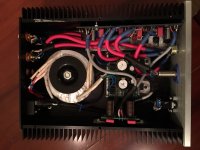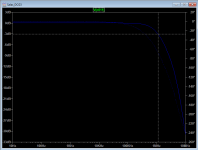Ilion is not too far from center. My "magic bus" has become the Wandering Jew lately so don't expect anything spectacular but I would be honored if you could have a listening to my system!
I am a city center dweller but if an opportunity comes, maybe if there will be some diyer friend's company also for the "extra urban trek" 😀 to I lion, I will let you know.
Salas, I'd like to understand why you chose an input resistor to ground of 330K which would essentially be the input impedance of the DCG3. Most of the preamps and amps I see have around 47k, maybe 100k. Why so high?
Thanks. nash
Thanks. nash
Not to mess with the value and log taper of the pot preceding it since the almost zero gate current of the JFET input allows me high impedance. The pot value will be the input impedance. If it has to be used straight without a pot, you can put whatever lower than 330k.
Not to mess with the value and log taper of the pot preceding it since the almost zero gate current of the JFET input allows me high impedance. The pot value will be the input impedance. If it has to be used straight without a pot, you can put whatever lower than 330k.
Thanks. I forgot all about the pot.
Noob questions on potentiometer values
I am planning to place the order for potentiometers today and requesting some guidance.
- What is(are) an ideal values for a potentiometer for the DCG3? On the thread I have seen 20k, 50k and 25k mentioned.
I am planning to use the Salas Input Selector (In-Selector, Tea-Bag PCB) board too; understand that the input selector board also has a volume pot - if using the Input Selector board:
- Which volume pot will be operational (installed) DCG3 or Input selector?
- What is an ideal value of the pot for the Input Selector? IIRC Alps RK27 is 100 Ohms?
Thanks in advance.
I am planning to place the order for potentiometers today and requesting some guidance.
- What is(are) an ideal values for a potentiometer for the DCG3? On the thread I have seen 20k, 50k and 25k mentioned.
I am planning to use the Salas Input Selector (In-Selector, Tea-Bag PCB) board too; understand that the input selector board also has a volume pot - if using the Input Selector board:
- Which volume pot will be operational (installed) DCG3 or Input selector?
- What is an ideal value of the pot for the Input Selector? IIRC Alps RK27 is 100 Ohms?
Thanks in advance.
Can use a 20K Log Alps blue stereo. Its both an in-range value and sits directly on the selector pcb
Can use a 20K Log Alps blue stereo. Its both an in-range value and sits directly on the selector pcb
Hi Salas,
Thank you for your suggestion.
If I am understanding correctly, when using the selector PCB, then no pot on the DCG3 board.
The DCG3 unit pcb has no physical place for a pot. Its always external to it. Either a directly on chassis supported pot or put on a selector/attenuator pcb.
Updated my DCG3 (maybe I should call it DCG5) to more gain (2K/R6), changed R3 to 178R to keep J3 at 4-5mA and added a 20K pot (had 10K before) and all Mogami 2549 internal wiring.
Hopefully, more gain will please the F5. Sounds good so far but I need more time.
Hopefully, more gain will please the F5. Sounds good so far but I need more time.
Attachments
Its still hardwarewise a 3 as long as it remains a triple Mosfet output config but you can call it 3.5 or Sebastian or whatever 
What brand/type is your new pot?

What brand/type is your new pot?
I thought the "3" was for the gain factor...
Ebay SMD stepped attenuator:
DACT Type SMD Stepped Attenuator 21 step Volume control pot D Shape Shaft | eBay
Seem to work well, I also have a Ladder stepped attenuator but it's too big to fit in that chassis.
Ebay SMD stepped attenuator:
DACT Type SMD Stepped Attenuator 21 step Volume control pot D Shape Shaft | eBay
Seem to work well, I also have a Ladder stepped attenuator but it's too big to fit in that chassis.
from post#1 "Its named DCG3 because it has DC servo and three MOSFETS. Its standard gain setting is also times three."
Yes its not bad at all for the price, I had used it before twice in builds, not top transparency vs expensive ones but has spot on channel balance as it is stepped resistors type of course. It also may ware out sooner than others and the number of steps is rather meh.
Yes its not bad at all for the price, I had used it before twice in builds, not top transparency vs expensive ones but has spot on channel balance as it is stepped resistors type of course. It also may ware out sooner than others and the number of steps is rather meh.
I will order a 20k one too for backup and variety vs my 50k Goldpoint now that you reminded me.
Now that we are on the subject of attenuators, I replaced my Tocos 50K with a DACT 10K I had. First amp was Sonnys TSSA and the impression was that it was more revealing with better stereo balance, but it was balancing on the edge of being a little hard on the highs. Then I put after some time it was resting, a tube amp I had, the Baby Huey, based on a design by Gingertube, and I felt it was a better synergy.
I have to switch back to the TSSA in order to be certain what I prefer most, but for the time, my tube amp is singing better than I ever remember.
Also, changed the input selector and cabling - I switch ground and phase for each input - in order to minimize loop area, and make Andrew happy!
I have to switch back to the TSSA in order to be certain what I prefer most, but for the time, my tube amp is singing better than I ever remember.
Also, changed the input selector and cabling - I switch ground and phase for each input - in order to minimize loop area, and make Andrew happy!
Attachments
How many pF your interconnects show when you unplug them and put the LCR meter across ring and tip of an RCA?
Measured at 1kHz with Tonghui LCR.
One is Blue Jean LC1, the other mil spec teflon silver plated cooper.
I also have some Van Damme, but I prefer the former for my subs.
I plan to replace with something of less capacitance, maybe Blue Jean, have not decided yet.
One is Blue Jean LC1, the other mil spec teflon silver plated cooper.
I also have some Van Damme, but I prefer the former for my subs.
I plan to replace with something of less capacitance, maybe Blue Jean, have not decided yet.
I don't see you are facing anywhere near a narrowed bandwidth problem yet with 10K pot & 10K//1nF load in simulation (that is why I was asking your measured figures so to plug them in). Here is its closed loop at half your pot for your 2x gain loaded with your 6m//6m cable runs to the amps. Phase margin with your specifics simulates as 94 degrees in open loop also. All well.
The speakers new arrangement looks nice. How is it going with the new HF horn and overhauled crossover, and how do you like the DCG3 after, what, a couple of months maybe?
The speakers new arrangement looks nice. How is it going with the new HF horn and overhauled crossover, and how do you like the DCG3 after, what, a couple of months maybe?
Attachments
You could also try verify that bandwidth with a 10K load resistor across two output cables in parallel on a channel and the scope's probe attached at that resistor. Feeding 1V 1kHz sinewave from the generator when the pot is split equally for worst case response and your 2x gain gives 1V output again. Wind the frequency up until you read 0.71V. For finding your practical -3dB supersonic reach.
- Home
- Source & Line
- Analog Line Level
- Salas DCG3 preamp (line & headphone)

![IMG_20170206_195039[1].jpg](/community/data/attachments/547/547191-7356c19644f8b87f52d7c47ef26dedc4.jpg?hash=c1bBlkT4uH)
![IMG_20170206_195708[1].jpg](/community/data/attachments/547/547222-7bac0c9b5d394528f8dcee8cd5568770.jpg?hash=e6wMm105RS)
